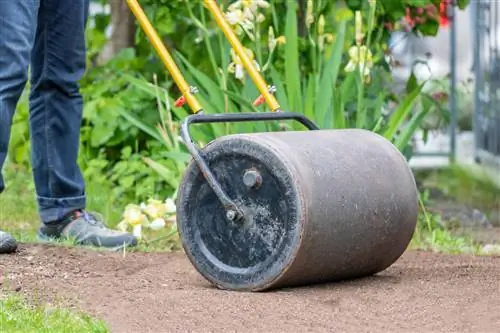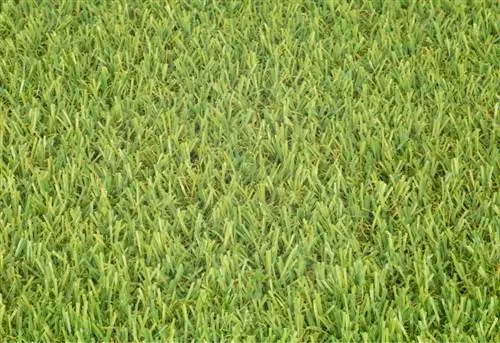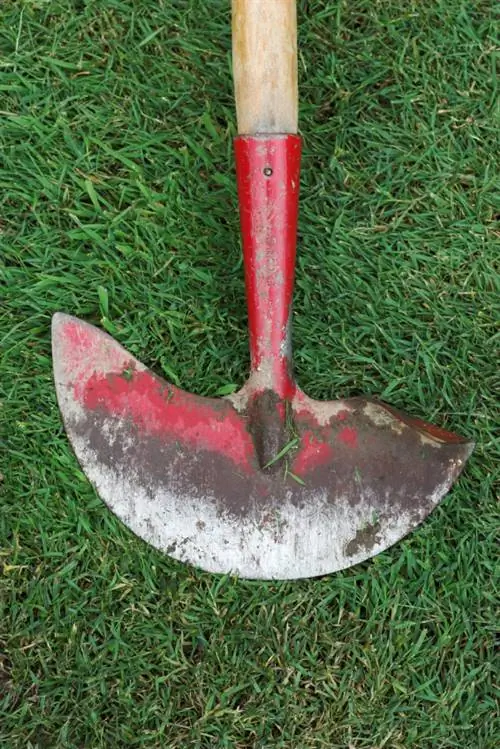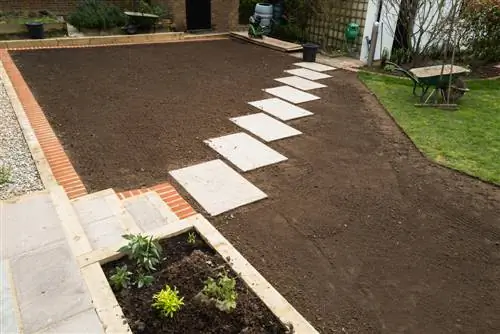- Author admin [email protected].
- Public 2023-12-16 16:46.
- Last modified 2025-06-01 06:02.
Don't stress about a sparse, patchy lawn. With professional reseeding, the problem can be solved in no time. The following instructions explain in practical terms when you should ideally sow the lawn seeds and what you should pay attention to.

When and how should you reseed lawns?
The best time for reseeding lawn seeds is in spring (March/April) or autumn. The soil should be prepared, aerated and suitable lawn seeds selected. Water regularly after sowing and fertilize later to achieve optimal results.
When is the best time to re-sow lawn seeds?
There are primarily two dates per year that are recommended for reseeding:
- In spring, when the lawn does not recover from the stresses of winter in March/April
- In autumn, when summer stress is reflected in gaps, holes and bare spots
In principle, all months of the growing season are eligible for reseeding, as long as there is no sweltering summer heat or there is no frost for the first time in autumn.
Professional preparation of the floor - this is how it works
It is worth preparing the lawn specifically for reseeding. If you simply spread lawn seeds on the patchwork carpet, you shouldn't be surprised if the delicate seeds don't germinate. This is how you prepare the lawn perfectly for receiving the seeds:
- Mow the grass area about 2 centimeters short
- Scarify 3-5 millimeters deep in the longitudinal and transverse directions
- Treat individual spots on the lawn with the hand scarifier
- Remove all combed out moss and weeds
The scarifier not only removes the thatch, but also loosens the turf with its rotating blades. In addition, the competitive strength of the remaining grasses should be somewhat weakened in this way so that the young seedlings can establish themselves. This form of preparation makes laborious digging of the entire lawn or bare areas unnecessary.
Aerification improves the chances of success
If reseeding serves to repair the entire lawn, experienced hobby gardeners add an intermediate step after scarifying. The sod is thoroughly aerated using an aerator. This is particularly recommended if soil compaction is responsible for bare spots. How to proceed:
- Perforate the lawn with a manual or mechanical aerator (€139.00 on Amazon)
- Press the high soil nails into the turf at a distance of 15-20 centimeters
- Remove the pushed-out soil from the lawn
Before reseeding, the lawn is sanded. To do this, distribute half a bucket of fine-grained quartz sand per square meter and sweep it into the holes with a rake or broom. In this way, the lawn also receives drainage, which effectively counteracts further compaction.
The best lawn seeds for reseeding - an overview
The exemplary preparation of the battered lawn for reseeding is only crowned with satisfactory success when the suitable lawn seeds are used. Forward-looking hobby gardeners therefore keep a supply of seeds after planting new ones. Where there is no longer any inventory available, the focus is on what is available on the market. The following overview presents proven seed mixtures for lawn repair:
| Lawn seeds for reseeding | Loretta Raparatur lawn seeds | Kiepenkerl Profi Line Complete | Ecostar youth work | GF Regeneration Grass | Wolf Garten Turbo Reseeding | Neudorff without gaps |
|---|---|---|---|---|---|---|
| Category | Commercial and ornamental lawns | Sports, play and landscape lawns | all types of lawn | all types of lawn | Sports and play turf, golf courses | Commercial and ornamental lawns |
| Location | sunny to partially shaded | sunny to partially shaded | all layers | all layers | sunny | sunny |
| Sowing rate | 20 g/m² | 20 g/m² | 40 g/m² | 30 g/m² | 20 g/² | 400 g/m² |
| Advantages | no starting fertilization required | also closes larger gaps | high resilience | cheap in price | natural germ accelerator | with living microorganisms |
| Disadvantages | slow growth | weak germination | low density | low resilience | hesitant to no germination | high consumption |
| Price | 23.00 euros/kg | 18.00 euros/kg | 4.00 euros/kg | 3, 10 euros/kg | 15, 20 euros/kg | 12 Euro/kg |
Tip
The much-praised lawn repair sets have not yet proven themselves in practical tests. The complete mixtures of lawn seeds, special substrate and fertilizer are not a sensible combination. In the classic cultivation of plants, hobby gardeners use nutrient-poor substrate to support germination. Of all things, the fine lawn seeds are supposed to germinate as lawn paving in direct contact with mineral-organic fertilizer - which of course only happens very hesitantly.
The perfect reseeding - step-by-step instructions
Regardless of whether you sow lawn seeds in spring or autumn, the procedure following the preparatory work follows this sequence:
- Compensate unevenness on the surface with a mix of garden soil and sand
- Spread the lawn seeds by hand or with a spreader
- Use a rake to lightly work the grass seeds into the ground and roll them
- Sift the light germinators thinly with sand or special lawn soil
- Last but not least, sprinkle the reseeding with the lawn sprinkler
Reseeding by hand is done evenly if you weigh out a handful of lawn seeds beforehand. This will give you a feel for the right dosage. When reseeding the entire area, you should ideally scatter the seeds in a checkerboard pattern, once lengthwise and once crosswise.
Always keep an eye on the weather forecast
Reseeding lawns differs only slightly from growing young plants by sowing. The light and temperature conditions have a significant influence on the successful course of germination. For lawn seeds, this means taking the weather forecast into account in both spring and fall before starting work. These weather conditions ensure rapid germination of lawn seeds:
- There are constant temperatures of a minimum of 8-10 degrees Celsius
- Neither a period of drought nor continuous rain are expected
- In autumn the first frost should wait at least 4 weeks
Tip
Lawn seeds cope with the critical phase until germination even better when they are sown in conjunction with the vermiculite seed aid. The fine-leaved silicate supports even distribution and protects the seeds from harmful weather influences. Since the tiny plates reflect light and store water, the lawn seeds are well protected from drying out.
Proper care after lawn repair
The lawn seeds usually germinate after 8 to 14 days. They must not dry out during germination, so regular watering is a top priority. If the delicate grasses sprout everywhere on the area and close all the gaps, this care is important:
- Fertilize the lawn for the first time after the seedlings have emerged
- Then spray repeatedly until all the fertilizer grains have been rained in
- When the grass has reached a height of 8-10 centimeters, it is mowed
- When making the first cut, do not mow deeper than 5 centimeters - 7 centimeters for shaded lawns
Experts are increasingly moving away from simultaneous reseeding and fertilization. In order to encourage seeds of any type of plant to germinate, a lean, nutrient-poor environment must be created. In this way, grass seeds are encouraged to make an effort in search of food. However, if the nutrient table right on your doorstep is rich thanks to fertilization, there is no reason for the seeds to develop strong roots.
Tip
If you fertilize the reseeding in autumn with a potassium-concentrated preparation, this caution will make a significant contribution to strengthening the winter hardiness of the lawn. If the pH value is too low and requires the application of lime, an interval of 2-3 weeks between the two care measures is advisable.






